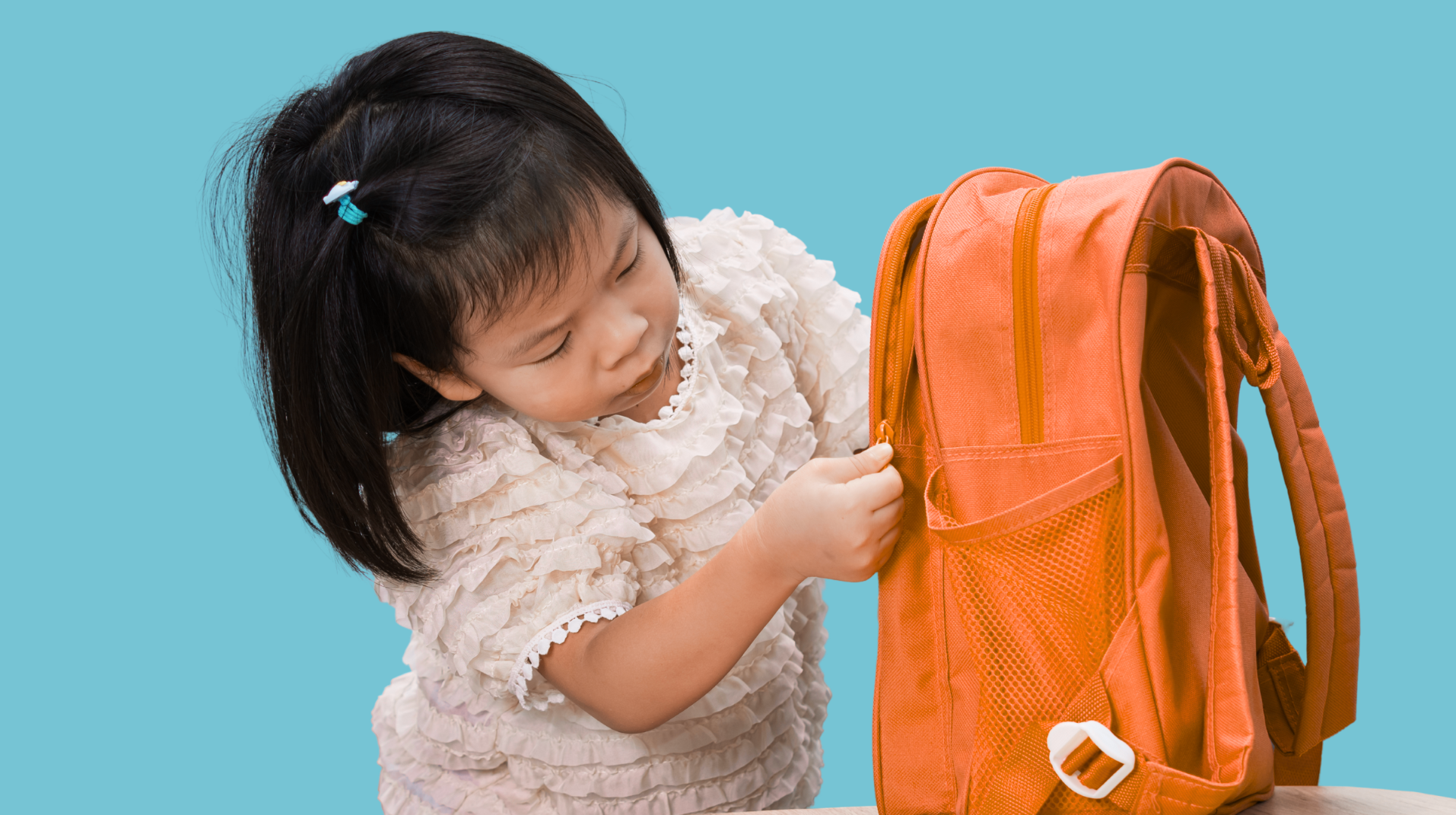Back to school
Supporting Your Child's Success This Fall
As the school year kicks off, the Pediatric Movement Center is here to help your family start strong. We know that transitioning back to school can bring excitement, challenges, and lots of questions—so we’ve created a comprehensive Fall 2025 campaign to help support your child every step of the way. From therapy tips and healthy lunch ideas to movement routines and fun events, our team is ready to help children of all ages feel confident, regulated, and ready to learn.
Information in this post have been created and curated by our physical, occupational, speech, and nutrition therapists as well as our Community Wellness team to make your family's transition to school more successful. Whether your child is entering preschool or heading into high school, you’ll find age-appropriate strategies, easy-to-follow routines, and encouragement at every turn.
Building Healthy Lunches & Snacks Habits
A new school year is the perfect time to build strong, healthy habits—and it all starts with what we fuel our bodies with. Whether your child is in preschool or high school, providing balanced lunches and nourishing snacks can make a big difference in their energy, focus, and mood throughout the day. A combination of protein, healthy fats, fruits, veggies, and whole grains supports not only physical growth but also emotional regulation and learning. By packing smart and starting small, families can create lasting routines that support wellness at every age. Our Registered Dietitian has curated shopping lists, menus, and practical resources to help your family start the year off on the right foot—feeling energized, prepared, and nourished for success.
Nutrition Tips & Resources
- Our grocery shopping list that includes fun ways to shop, such as by textures, colors, and themes (like ABC's!)
- Kids can be a great help in the kitchen! Getting children involved in the kitchen from a young age opens the door to new experiences with food in a low-pressure, playful environment.
- Smart snacking ideas plus a few tips to make your life a little easier (for the whole family!) that includes suggestions for breakfast, snacks, lunches and hydration
- For a fun take on lunches, our kid-friendly charcuterie ideas can help children with various sensory needs experience various foods and textures in a fun low-pressure way.
- Download our lunch guide; and let your kids take an active role in picking/preparing their meals
- Make a few
snack swaps to be healthier this year!
Preschool & Kindergarten Students
The first day of preschool or kindergarten is a major milestone—one filled with big emotions for both children and parents. While there’s excitement about new friends, colorful classrooms, and wearing that first “big kid” backpack, it’s also natural to feel nervous about new routines, separation, and the unknowns of the school day. To help ease the transition, we’ve put together therapy-based tips that support confidence and independence, along with simple morning movement routines to release energy and improve focus. Our goal is to make the start of school feel smoother, calmer, and more successful for the whole family. You’ll also find practical strategies for creating consistent routines at home, making morning goodbyes easier, and supporting your child’s emotional regulation—so they feel ready to thrive in their new environment.
DOWNLOADABLE /ADDITIONAL RESOURCES
PT
Physical Therapy Tip
Practice Backpack Safety
Choose a lightweight backpack with wide, padded straps. Keep the load to less than 10–15% of your child’s body weight.
SLP
Speech Therapy Tip
Read Together Daily
Read aloud with your child and pause to talk about the pictures, make predictions, or retell the story.
OT
Occupational Therapy Tip
Build Attention & Listening Skills
Practice listening games like “Simon Says” or “Red Light, Green Light”
MOVE
Movement Tip
Cross-Crawl March
Boost coordination, brain-body connection, and focus.
Elementary School Students
The elementary school years are filled with curiosity, growth, and new responsibilities. As children learn to navigate classroom routines, friendships, academic expectations, and extracurriculars, they begin building the confidence and independence that will carry them through later school years. These are exciting milestones—but they can also come with challenges like managing big emotions, staying focused, and adjusting to increased structure. For many families, the transition into a new school year brings a mix of anticipation and uncertainty. Helping your child feel prepared—physically, emotionally, and socially—can make a big difference. From movement routines that support focus and body awareness, to tips that encourage organization, confidence, and emotional regulation, simple strategies at home can go a long way in setting your child up for success.
DOWNLOADABLE /ADDITIONAL RESOURCES
PT
Physical Therapy Tip
Sensory-Motor Regulation
Practice short movement breaks like wall push-ups, stretching, or jumping jacks before homework to help manage restlessness and improve focus.
SLP
Speech Therapy Tip
Practice Conversation Skills
Take turns asking and answering “Would you rather…?” or “What if…?” questions to improve social communication and turn-taking.
OT
Occupational Therapy Tip
Develop Pencil Control
Trace mazes, draw shapes, or copy simple designs with a marker or chalk to improves precision and fine motor coordination for writing.
MOVE
Movement Tip
Wiggle Jumps
Do 10–15 jumping jacks or “star jumps” to shake out energy to increase alertness and burn off extra wiggles.
Middle School Students
Middle school is a time of big changes—socially, emotionally, and academically. Students are juggling shifting routines, growing academic expectations, increased independence, and complex peer relationships. It’s a season full of self-discovery and rapid development, but it can also bring challenges like difficulty with focus, organization, emotional regulation, and self-esteem.
Fortunately, there are simple strategies from physical therapy, occupational therapy, speech-language pathology, nutrition, and movement that can make this transition smoother. For example, physical therapy tips like incorporating short movement breaks throughout the day can help improve focus and reduce stress. Occupational therapy offers tools for better organization, such as using checklists or visual planners to manage homework and activities. Speech therapy strategies can boost communication skills and help students confidently navigate social situations. Nutrition guidance reminds us that balanced meals and snacks fuel both the brain and body for optimal performance, and movement routines—like mindful stretching or deep breathing exercises—can support emotional regulation & calmness.
DOWNLOADABLE /ADDITIONAL RESOURCES
PT
Physical Therapy Tip
Desk & Seat Posture Check
Reduce fatigue and discomfort during long classes.
- Keep feet flat, back supported, and shoulders relaxed.
SLP
Speech Therapy Tip
Expand Vocabulary with Real-Life Connections
Improve comprehension and makes academic language less intimidating.
- Link new words from class to personal experiences or favorite topics.
OT
Occupational Therapy Tip
Support Sensory Regulation
Help your child stay calm and focused during the day.
- Teach calming strategies like deep breathing or stretching between classes.
MOVE
Movement Tip
Brain Break Movement Bursts
Re-energizes the body and brain between classes or homework.
- Jumping jacks, high knees, or march in place for 30 seconds.
High School Students
High school is a pivotal and demanding time filled with new responsibilities, academic pressures, social challenges, and important decisions about the future. Students are learning to manage busy schedules, balancing schoolwork, extracurricular activities, part-time jobs, and social lives. While this stage offers tremendous opportunities for growth and self-discovery, it can also bring stress, difficulty with time management, physical fatigue, and emotional ups and downs. Fortunately, simple strategies from physical therapy, occupational therapy, speech-language pathology, nutrition, and movement can provide valuable support to help high school students stay balanced, focused, and confident during this critical phase.
DOWNLOADABLE /ADDITIONAL RESOURCES
PT
Physical Therapy Tip
Posture Checks
Shoulders back, chin tucked, feet flat during class
SLP
Speech Therapy Tip
Chunk Reading Assignments
Break long passages into smaller parts and summarize each.
OT
Occupational Therapy Tip
Plan Your Day the Night Before
Use a written or digital planner to map homework, activities, and self-care time.
MOVE
Movement Tip
Morning “Wake-Up” Stretch Flow
Begin each morning with 5–7 minutes of stretching: neck rolls,
shoulder shrugs and rolls, overhead arm stretches and standing side bends.









